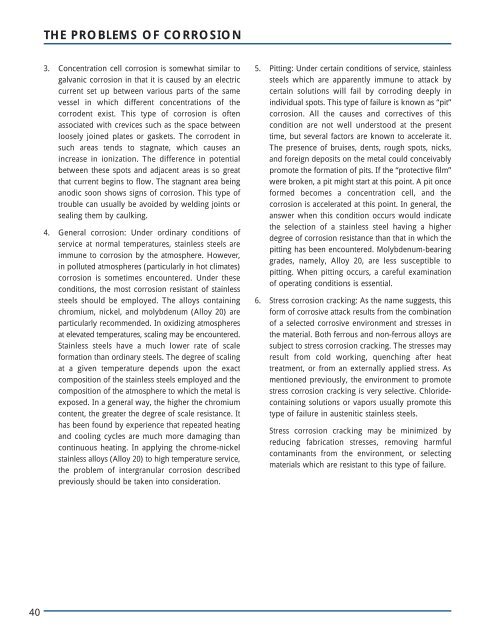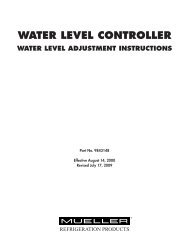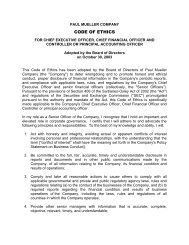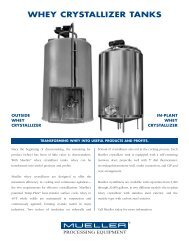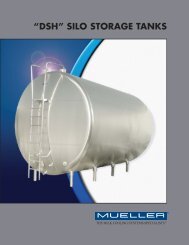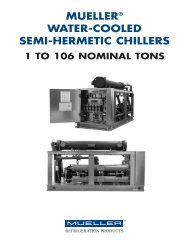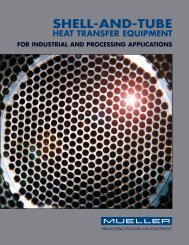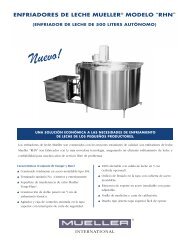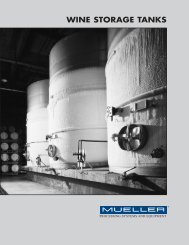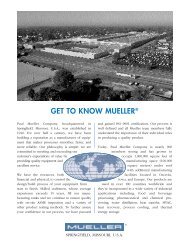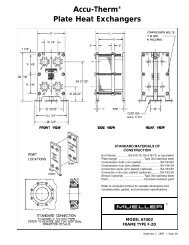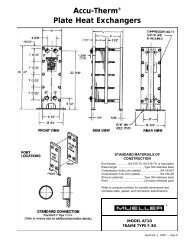ALL ABOUT TEMP-PLATE® - Paul Mueller Company
ALL ABOUT TEMP-PLATE® - Paul Mueller Company
ALL ABOUT TEMP-PLATE® - Paul Mueller Company
You also want an ePaper? Increase the reach of your titles
YUMPU automatically turns print PDFs into web optimized ePapers that Google loves.
40<br />
THE PROBLEMS OF CORROSION<br />
3. Concentration cell corrosion is somewhat similar to<br />
galvanic corrosion in that it is caused by an electric<br />
current set up between various parts of the same<br />
vessel in which different concentrations of the<br />
corrodent exist. This type of corrosion is often<br />
associated with crevices such as the space between<br />
loosely joined plates or gaskets. The corrodent in<br />
such areas tends to stagnate, which causes an<br />
increase in ionization. The difference in potential<br />
between these spots and adjacent areas is so great<br />
that current begins to flow. The stagnant area being<br />
anodic soon shows signs of corrosion. This type of<br />
trouble can usually be avoided by welding joints or<br />
sealing them by caulking.<br />
4. General corrosion: Under ordinary conditions of<br />
service at normal temperatures, stainless steels are<br />
immune to corrosion by the atmosphere. However,<br />
in polluted atmospheres (particularly in hot climates)<br />
corrosion is sometimes encountered. Under these<br />
conditions, the most corrosion resistant of stainless<br />
steels should be employed. The alloys containing<br />
chromium, nickel, and molybdenum (Alloy 20) are<br />
particularly recommended. In oxidizing atmospheres<br />
at elevated temperatures, scaling may be encountered.<br />
Stainless steels have a much lower rate of scale<br />
formation than ordinary steels. The degree of scaling<br />
at a given temperature depends upon the exact<br />
composition of the stainless steels employed and the<br />
composition of the atmosphere to which the metal is<br />
exposed. In a general way, the higher the chromium<br />
content, the greater the degree of scale resistance. It<br />
has been found by experience that repeated heating<br />
and cooling cycles are much more damaging than<br />
continuous heating. In applying the chrome-nickel<br />
stainless alloys (Alloy 20) to high temperature service,<br />
the problem of intergranular corrosion described<br />
previously should be taken into consideration.<br />
5. Pitting: Under certain conditions of service, stainless<br />
steels which are apparently immune to attack by<br />
certain solutions will fail by corroding deeply in<br />
individual spots. This type of failure is known as “pit”<br />
corrosion. All the causes and correctives of this<br />
condition are not well understood at the present<br />
time, but several factors are known to accelerate it.<br />
The presence of bruises, dents, rough spots, nicks,<br />
and foreign deposits on the metal could conceivably<br />
promote the formation of pits. If the “protective film”<br />
were broken, a pit might start at this point. A pit once<br />
formed becomes a concentration cell, and the<br />
corrosion is accelerated at this point. In general, the<br />
answer when this condition occurs would indicate<br />
the selection of a stainless steel having a higher<br />
degree of corrosion resistance than that in which the<br />
pitting has been encountered. Molybdenum-bearing<br />
grades, namely, Alloy 20, are less susceptible to<br />
pitting. When pitting occurs, a careful examination<br />
of operating conditions is essential.<br />
6. Stress corrosion cracking: As the name suggests, this<br />
form of corrosive attack results from the combination<br />
of a selected corrosive environment and stresses in<br />
the material. Both ferrous and non-ferrous alloys are<br />
subject to stress corrosion cracking. The stresses may<br />
result from cold working, quenching after heat<br />
treatment, or from an externally applied stress. As<br />
mentioned previously, the environment to promote<br />
stress corrosion cracking is very selective. Chloridecontaining<br />
solutions or vapors usually promote this<br />
type of failure in austenitic stainless steels.<br />
Stress corrosion cracking may be minimized by<br />
reducing fabrication stresses, removing harmful<br />
contaminants from the environment, or selecting<br />
materials which are resistant to this type of failure.


